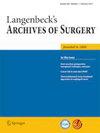摘要
背景:在过去二十年中,机器人辅助胃切除术已成为治疗胃癌(GC)的一种广泛采用的手术方案。尽管它很受欢迎,但术后并发症会严重恶化患者的生活质量和预后。因此,识别这些并发症的风险因素对于早期发现和干预至关重要:本研究旨在构建并验证一个预测模型,用于评估机器人辅助根治性胃切除术患者术后并发症的风险:方法:对甘肃省人民医院 2016 年 12 月至 2023 年 10 月间的 500 例胃癌患者进行回顾性分析。这些患者构成了培训队列。另有 136 名来自中国人民解放军联合后勤保障部队第 940 医院的患者作为外部验证队列。患者被分为有并发症和无并发症两组。收集的数据包括人口统计学细节、实验室结果、CT 定量身体成分分析和临床信息。通过拉索回归对变量进行选择,然后通过多变量逻辑回归找出独立的风险因素。这些因素有助于构建一个用于预测的提名图。该模型的性能通过自举技术进行了内部验证,并通过验证队列进行了外部验证。该模型的功效通过接收者操作特征曲线(ROC)下面积(AUC)进行量化,使用校准曲线和 Hosmer-Lemeshow 检验对校准进行评估,并通过决策曲线分析(DCA)对临床实用性进行评估:结果:在训练队列的 500 名患者中,有 65 人出现并发症,发生率为 13%。验证队列的并发症发生率类似,为 13.24%(136 名患者中有 18 人)。确定的独立风险因素包括肿瘤直径(OR = 1.99,95% CI = 1.07-3.73)、TNM III 期(OR = 2.12,95% CI = 1.03-4.36)、ASA I 级(OR = 0.26,95% CI = 0.13-0.53)、ASA III 级(OR = 4.75,95% CI = 2.12-10.62)和内脏脂肪面积(VFA)(OR = 2.52,95% CI = 1.10-5.79)。在内部验证和外部验证中,提名图分别显示出良好的区分度(AUC = 0.81,95% CI:0.76-0.87)和(AUC = 0.79,95% CI:0.67-0.90)。这两项验证都证实了该模型的精确校准和显著的临床实用性,在概率阈值为2%至79%和2%至71%时观察到了净获益:所开发的提名图基于五个独立的风险因素--肿瘤直径、TNM III 期、ASA I 级、ASA III 级和 VFA,能有效预测接受机器人辅助根治性胃切除术患者的并发症风险,为临床决策提供了有价值的工具。Background: In the last two decades, robotic-assisted gastrectomy has become a widely adopted surgical option for gastric cancer (GC) treatment. Despite its popularity, postoperative complications can significantly deteriorate patient quality of life and prognosis. Therefore, identifying risk factors for these complications is crucial for early detection and intervention.
Objective: This research is designed to construct and validate a predictive model for assessing the risk of postoperative complications in patients undergoing robotic-assisted radical gastrectomy.
Methods: A retrospective analysis was conducted on 500 GC patients from Gansu Provincial People's Hospital between December 2016 and October 2023. These patients formed the training cohort. An additional 136 patients from the 940th Hospital of Joint Logistic Support Force, the Chinese People's Liberation Army as the external validation cohort. Patients were categorized into groups with and without complications. Data collected included demographic details, laboratory results, CT quantitative body composition analysis, and clinical information. Variable selection was conducted through Lasso regression, succeeded by multivariable logistic regression to pinpoint independent risk factors. These elements facilitated the construction of a nomogram for prediction. The model's performance underwent internal validation via bootstrap techniques and external validation through a validation cohort. The efficacy of the model was quantified by the area under the receiver operating characteristic (ROC) curve (AUC), evaluated for calibration using calibration curves and the Hosmer-Lemeshow test, and assessed for clinical utility through decision curve analysis (DCA).
Results: Of the 500 patients in the training cohort, 65 experienced complications, a rate of 13%. The validation cohort had a similar complication rate of 13.24% (18 out of 136 patients). Independent risk factors identified included tumor diameter (OR = 1.99, 95% CI = 1.07-3.73), TNM stage III (OR = 2.12, 95% CI = 1.03-4.36), ASA class I (OR = 0.26, 95% CI = 0.13-0.53), ASA class III (OR = 4.75, 95% CI = 2.12-10.62), and visceral fat area (VFA) (OR = 2.52, 95% CI = 1.10-5.79). The nomogram demonstrated good discrimination (AUC = 0.81, 95% CI: 0.76-0.87) in internal validation and (AUC = 0.79, 95% CI: 0.67-0.90) in external validation. Both validations confirmed the model's accurate calibration and significant clinical utility, with net benefits observed at probability thresholds ranging from 2 to 79% and 2-71%.
Conclusion: The developed nomogram, based on five independent risk factors-tumor diameter, TNM stage III, ASA class I, ASA class III, and VFA-effectively predicts the risk of complications in patients undergoing robotic-assisted radical gastrectomy, offering a valuable tool for clinical decision-making.

 求助内容:
求助内容: 应助结果提醒方式:
应助结果提醒方式:


